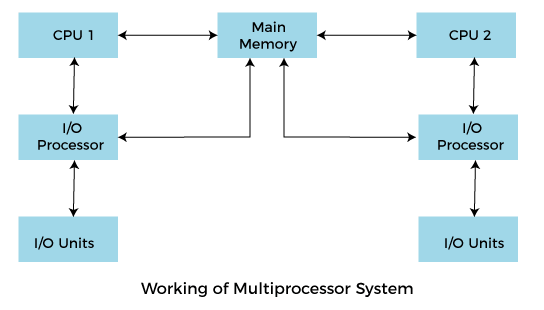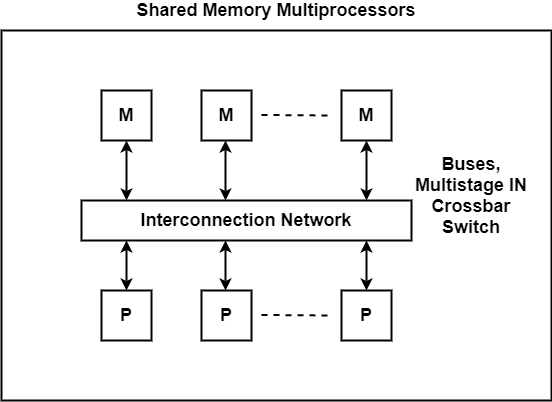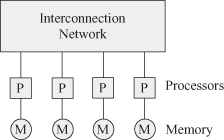MULTIPROCESSOR ARCHITECTURE
YUKTHA BHUSHAN H
MULTIPROCESSOR ARCHITECTURE
Introduction to Multiprocessor:
Multiprocessor is a system with two or more central processing units (CPU's) that is capable of performing multiple tasks. A multiprocessor is a computer system with two or more central processing units that share full access to a common RAM. The main objective of multiprocessor is to boost the system's execution speed. The other objectives are fault tolerance and application matching.
Types of Multiprocessor:
1. Shared memory multiprocessor - A shared-memory multiprocessor is an architecture consisting of a modest number of processors, all of which have direct (hardware) access to all the main memory in the system.
This permits any of the system processors to access data that any of the other processors has created or will use. The key to this kind of multiprocessor architecture is the interconnection network that directly connects all the processors to the memories. This is complicated by the need to retain cache coherence across all caches of all processors in the system.
The limitation of shared memory multiprocessor is memory access latency.
Shared memory multiprocessors have a major benefit over other multiprocessors since all the processors sent a similar view of the memory.
These processors are also known as Uniform Memory Access (UMA) systems. This term indicates that memory is equally accessible to all processor, providing access at the same performance rate.
2. Distributed memory multiprocessor: A distributed-memory multiprocessor (DMM) is a computer system in which each processor has its own private memory.
Distributed memory systems are easier to build but hard to use, getting along with many shared memory computers each with their own operating system and their own separate memory.
If the distributed memory multiprocessor is composed of identical processors, then it is called as symmetric multiprocessor (SMP). If the distributed memory multiprocessor is prepared of heterogenous processors, then it is called as an Asymmetric multiprocessor (ASMP).
Memory access by a processor is not uniform since it relies on which memory module the processor is trying to access, this is called a Non Uniform Memory Access multiprocessor system.
Benefits of multiprocessor:
1. Multi-tasking inside an application.
2. Enhanced performance
3. Multiple applications
4. High throughput and responsiveness
5. Hardware sharing among CPU's
Advantages:
1. Multiprocessor systems have better scalability.
2. Multiprocessor systems have improved performance, that is, it can execute tasks faster than other systems.
3. Multiprocessor systems are cost reduced, that is, it can be more cost-effective than multiple single system.
4. Multiprocessor has increased reliability, that is, it operates even if one processor fails.
5. Multiprocessor systems allow for grater parallelism.
Disadvantages:
1. Multiprocessor systems are more complex than single-processor systems.
2. Multiprocessor systems require more power to operate than single-processor systems.
3. Developing software that can effectively use multi processors can be more challenging.
4. All the applications cannot be benefitted from multiprocessor systems and can only see limited performance gains.
5. Sometimes, there might be synchronization issues between processors to ensure that tasks are executed correctly.
The limitation of shared memory multiprocessor is memory access latency.
Shared memory multiprocessors have a major benefit over other multiprocessors since all the processors sent a similar view of the memory.
These processors are also known as Uniform Memory Access (UMA) systems. This term indicates that memory is equally accessible to all processor, providing access at the same performance rate.
2. Distributed memory multiprocessor: A distributed-memory multiprocessor (DMM) is a computer system in which each processor has its own private memory.
Distributed memory systems are easier to build but hard to use, getting along with many shared memory computers each with their own operating system and their own separate memory.
If the distributed memory multiprocessor is composed of identical processors, then it is called as symmetric multiprocessor (SMP). If the distributed memory multiprocessor is prepared of heterogenous processors, then it is called as an Asymmetric multiprocessor (ASMP).
Memory access by a processor is not uniform since it relies on which memory module the processor is trying to access, this is called a Non Uniform Memory Access multiprocessor system.
Benefits of multiprocessor:
1. Multi-tasking inside an application.
2. Enhanced performance
3. Multiple applications
4. High throughput and responsiveness
5. Hardware sharing among CPU's
Advantages:
1. Multiprocessor systems have better scalability.
2. Multiprocessor systems have improved performance, that is, it can execute tasks faster than other systems.
3. Multiprocessor systems are cost reduced, that is, it can be more cost-effective than multiple single system.
4. Multiprocessor has increased reliability, that is, it operates even if one processor fails.
5. Multiprocessor systems allow for grater parallelism.
Disadvantages:
1. Multiprocessor systems are more complex than single-processor systems.
2. Multiprocessor systems require more power to operate than single-processor systems.
3. Developing software that can effectively use multi processors can be more challenging.
4. All the applications cannot be benefitted from multiprocessor systems and can only see limited performance gains.
5. Sometimes, there might be synchronization issues between processors to ensure that tasks are executed correctly.







Comments
Post a Comment